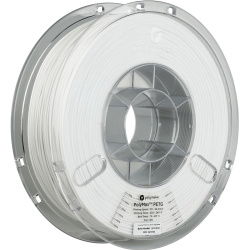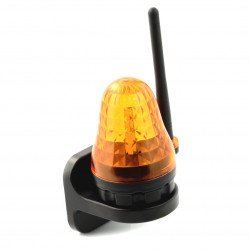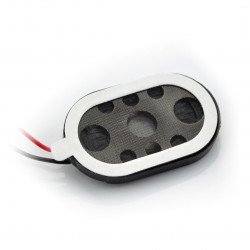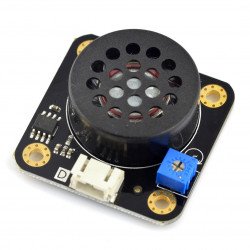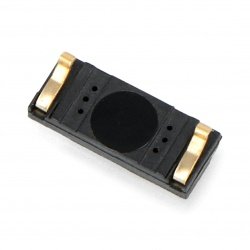Any device that needs to reproduce warning or information signals, voice messages or melodies requires a suitable sound transducer. In many applications small buzzers are sufficient, but when a wider acoustic bandwidth or good quality of generated sound is required, classic analogue loudspeakers come to the rescue. In this category you will find speakers of various sizes with parameters that will allow you to meet all the requirements of your new project.
Analog speakers
Speaker MG15 0.1W 8Ohm - 15x4mm
A speaker with a power of 0.1 W, 8 Ω, dimensions 15 x 4 mm.Speaker MG24-15 0.5W 8Ohm - 24x15x4mm
Speaker power 0.5 W, resistance 8 Ohm, and a size of 24 x 15 x 4 mm.Speaker YD27 0.5W 8Ohm - 27x5mm
The loudspeaker is 0.5 W, has a resistance of 8 Ω and measures 27 x 5 mm.Speaker YD50-P 0.5W 8Ohm - 50x17mm
Speaker power 0.5 W, resistance 8 Ohm, dimensions 50 x 17 mm.Module with loudspeaker for testing A/C and C/A converters - Waveshare 3972
Module with amplifier LM386M, speaker and two high precision potentiometers, that allows you to check external converters analog-to-digital and digital-to-analog.Bone Conductor Transducer - pressure speaker - 1W - Adafruit 1674
Miniature pressure speaker that converts any flat surface into a sound source. Does not need air for raising the voice. It can be applied directly to the head and not heard by...Speaker YD50 0.5W 8Ohm - 50x17mm
The loudspeaker is 0.5 W, has a resistance of 8 Ω and measures 50 x 17 mm.Mini Oval Speaker 1W 8Ohm - 30x20x5mm - Adafruit 4227
Small speaker with 1W power and 8 ohm resistance. It is equipped with a 2-pin JST connector with a 1.25 mm pitch so you can plug it directly into consoles such as PyGamer...Speaker YD40 0.25W 50Ohm - 40x16mm
Speaker power 0.25 W, impedance of 50 Ohms, and dimensions of 40 x 16 mm.Speaker YD30 0.5W 8Ohm - 28x12mm
Speaker power 0.5 W, resistance 8 Ohm and dimensions of 15 x 12 mm.ISD1820 audio recording and playback module + speaker
Audio recording module based on the ISD1820 chip . It has a built-in microphone and an attached speaker. Built-in functions allow you to record and play back audio up to 10...Speaker 5W 8Ω - 100x45x21mm - 2pcs. - Waveshare 14595
The 5 Watt 8 ohm resistance speaker works with selected Waveshare screens. The set includes two loudspeakers with external dimensions of 100 x 45 x 21 mm.Speaker YD36 0.5W 8 Ohms - 40x5mm
Speaker power 0.5 W, resistance 8 Ohm, size 40 x 5 mm.Grove - a speaker with a digital interface
Speaker module Grove is a device controlled by the PWM signal. It c an work as a simple buzzer or audio player. The volume is adjustable with the built in potentiometer. The...- Discontinued product
DFRobot Gravity - a speaker with a digital interface
The module is based on the single-wire 8002 amplifier with digital interface. It can work as a simple buzzer or play music. The volume is adjustable with built in...1W 8Ohm speaker - 30mm - SparkFun COM-27247
This small 30mm diameter speaker is a great alternative to classic piezo buzzers in projects requiring better sound quality. With a plastic housing and a nominal power of 1W,...Speaker MG6-15 0.1W 32Ohm - 15x6x3mm
Speaker with power of 0.1 V, the resistance of 32 Ohms and a size of 15 x 6 x 3 mm.Analog speakers - the parameters and what they mean
All analog speakers are described by manufacturers using two basic quantitative parameters: power, expressed in watts (W) and impedance, specified in ohms (Ω). These parameters, however, say nothing about the frequency response of the speaker, which is of colossal importance for the sound quality. As a general rule, the larger the diameter of analogue speakers (or more precisely, their diaphragms), the better they are at reproducing low frequencies (including bass). Therefore, small analogue speakers, e.g. 15 mm MG15 or 28 mm YD30 are best suited for signalling tasks in mid and higher frequency bands (above several hundred hertz), while if you are looking for a speaker for a small radio or MP3 player based on Arduino - choose a slightly larger model YD78 or YD50.
Analog speakers for audio playback
For simple applications, where single tones or sequences of tones will be played, small analog speakers with foil diaphragm are perfect. In such cases, it will be most important to choose the appropriate speaker power and, consequently, dimensions (diameter and overall thickness). Speakers such as the 8-ohm YD36 with a power of 0.5 W and a diameter of 36 mm are surprisingly good at generating simple squeaks of varying intensity and frequency, although they are often used in small radios or toys, where they are able to clearly reproduce even music or speech. They will also work great in conjunction with sound modules (e.g. WAV/MP3 players) for Arduino, as well as in cooperation with minicomputers like Raspberry Pi. Be sure to check the maximum power that the output of a given module can deliver - you'll need to select a suitable amplifier if necessary.
Speakers that will rock at any party
For applications requiring more power we recommend large analog speakers A-165 from BLOW. In our store you will find two versions with the power of 200 W and impedances of 4 Ω and 8 Ω. Model A-165 has a very wide bandwidth - from bass (45 Hz) to high frequencies (6 kHz), which allows you to play music even without an additional subwoofer. Another very interesting solution are miniature analogue speakers Adafruit Bone Conductor Transducer, which transmit sound directly to the surface on which they are placed. In this way, a table, cabinet or everyday objects can become sources of surprisingly loud and pleasant sound. With this small transducer the phrase "jukebox" takes on a completely literal meaning!







































































































































































































































































































































